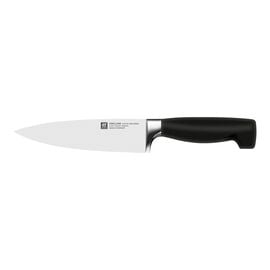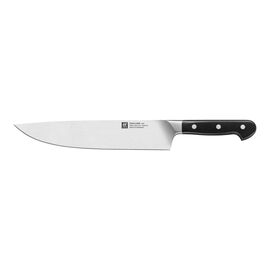Chef's Knives
Table of Contents
Selecting the Right Chef’s Knife
When it comes to choosing a chef’s knife, the options can be overwhelming, especially if you're not sure which are the important factors to consider. The three most important factors to consider include the length of the blade, whether it has rivets or not, and the material of the handle. When selecting which chef knife is a perfect match for you, you should first identify which qualities resonate most with your style. Start by considering the properties that matter most to you.
1. Blade Length
Chef's knives come in various blade lengths, typically ranging from 6 inches (15 cm) to 12 inches (30 cm) or more. The choice of blade length depends on personal preference and the specific tasks you plan to perform. Shorter blades offer more control for precise tasks, while longer blades are better for cutting larger items. To offer a clearer perspective, let's categorize each blade length into its intended purpose and ideal uses.
6 to 8 Inches (15 to 20 cm)
- This blade length range, often known as utility or petty knives, has been dubbed a "ladies' favorite" due to their compatibility with smaller hands. They are on the shorter end of the spectrum and are excellent for tasks that require precision and control.
- Consider these knives as precision tools, ideally crafted for tasks that demand the utmost accuracy and control.
- Their compact size makes them easy to maneuver and are especially ideal for more detailed work like peeling a tomato, trimming, or achieving intricate cuts on small fruits, vegetables, and herbs.
8 to 10 Inches (20 to 25 cm)
- This blade length range strikes a near-perfect balance between shorter and longer knives. It's long enough to tackle larger ingredients like melons or roasts with ease, yet still agile and delivers precise control for finer tasks. This efficiency reduces the need to switch between multiple knives during meal preparation.
- The added length of the blade and extended handle provide a comfortable grip and greater leverage, allowing for more force when needed—particularly useful for cutting through tough ingredients like butternut squash.
- The slightly longer blade provides increased control, especially compared to shorter knives. This control is essential when you require precision, whether it's for thinly slicing fragile foods or finely dicing herbs.
10 to 12 Inches (25 to 30 cm) or More
- 10 to 12 inches is the length that is recommended for professional cooks. However, it is a blade length that needs practice to use.
- These longer blades excel at tasks involving larger items or the need for sweeping cuts. Slicing roasts, carving large fish fillets, or sectioning sizable vegetables become remarkably efficient with their extended reach.
- The added length allows for more efficient single-stroke cutting, potentially resulting in time saved during food preparation.
- Despite their length, these knives still offer impressive control, particularly for precise cuts on larger ingredients. Whether it's creating precise portions or beautifully presented slices, their length enhances precision.
2. Blade Material
The choice of blade material has a significant and influential impact on how well a chef's knife functions or performs. The most popular blade materials for chef knives are stainless steel and carbon steel. High carbon stainless steel offers the advantages of both stainless and carbon steel.
Just as blade length impacts the performance of a chef's knife, the material of the blade significantly influences its functionality and maintenance requirements. Different blade materials offer distinct advantages and considerations, having a significant and influential effect on how well a chef's knife functions or performs. The most popular blade materials for chef knives are stainless steel and carbon steel. High carbon stainless steel offers the advantages of both stainless and carbon steel.
Stainless Steel Knives
Stainless steel knives are most commonly crafted from iron, carbon, and chromium, along with some other elements. The nickel and chromium form a protective layer on the carbon steel, preventing rust.
Advantages of Stainless Steel Knives
- Remarkable ability to withstand the harmful effects of rust, corrosion, and staining.
- Considered durable and can be used safely in a wide range of kitchen settings without damage caused.
Drawbacks of Stainless Steel Knives
- May not remain as sharp for as long as some other blade materials. Requires more frequent sharpening to maintain optimal cutting performance.
- Stainless steel blades tend to have a moderate weight, which may not be ideal for individuals who prefer lighter weight knives for extended use.
Carbon Steel
Mainly composed of iron and carbon, with minimal or no chromium added. Carbon steel is one of the sharpest blades available, adding carbon to iron strengthens and toughens steel, making it more resistant to deformities and scratching. Higher carbon content leads to greater hardness, which is highly beneficial.
Advantages of Carbon Steel Knives
- Harder than stainless steel, and will stay sharp for a longer time period.
- Carbon steel heats up quickly and distributes heat evenly, making it ideal for cooking tasks that require precise temperature control.
Drawbacks of Carbon Steel Knives
- While it maintains sharpness well, re-sharpening can be challenging due to its hardness.
- Carbon steel is prone to rust and corrosion. It demands consistent maintenance to prevent rust, which includes drying it thoroughly after use and periodic oiling.
High Carbon Steel Knives
Combines iron, carbon, and chromium, and engineered to have the positive qualities of both carbon steel and stainless steel. It retains its sharp edge like carbon steel, making it excellent for cutting, while also possessing the rust-resistant properties of stainless steel, ensuring it doesn't corrode or stain easily. Essentially, this material offers the benefits of both worlds.
Advantages of High Carbon Steel Knives
- These knives hold their edge well, ensuring consistent cutting performance, especially for tasks that demand precision.
- Responds quickly to honing, allowing for easy maintenance—and regular honing will keep the edge in top condition.
Drawbacks of High Carbon Steel Knives
- Due to their hardness, high carbon steel knives can be more challenging to resharpen when compared to softer steel types. Sharpening may require more skill and effort.
- These knives demand careful handling and maintenance to avoid rust and staining. Users must be vigilant about cleaning and storing them properly to preserve their performance and appearance.
Damascus Steel Knives
Damascus steel knives often combine two or more types of steel, such as high-carbon steel and low-carbon steel. The layering and folding of these different steels create the unique patterns and give the blade its exceptional strength and sharpness. The specific composition of a Damascus steel knife can vary widely, and it may include various alloys and elements chosen by the bladesmith to achieve the desired performance and aesthetics.
Advantages of Damascus Steel Knives
- These knives are known for their exceptional sharpness and edge retention, ensuring precise cutting.
- Damascus steel is often created by layering different types of steel, resulting in a blade that is both tough and resilient.
Drawbacks of Damascus Steel Knives
- Damascus steel knives can be expensive due to the labor-intensive forging process and the skill required to create the unique patterns.
- While the patterns are beautiful, they may wear down over time, affecting the knife's aesthetic appeal.
Although there are many different options like laminated and ceramic, stainless steel, carbon steel, and high carbon stainless steel are the predominant choices for a reason.
3. Knife Anatomy
Chef knives come in a range of blade constructions, tang configurations, and rivet placements, each of which plays a significant role in shaping their functionality and contributing to the knife's overall anatomy.
Full Tang: When the handle is mounted around the tang, as in our Professional “S” series, it is considered a full tang. Rivets are used to attach the handle to the tang, and so a full tang is generally visible.
Partial Tang: A partial tang knife has a blade that extends partway into the handle. While lighter, it may not be as robust as full tang knives.
Rivet: A rivet is a metal fastener commonly used in the construction of knives. Its primary purpose is to firmly attach the handle scales, which are the parts of the handle, to the tang of the knife. Rivets are typically positioned along the handle, serving to secure it firmly in place and ensure stability.
No Rivet: When a knife is described as "no rivet," it means that the handle of the knife is attached to the blade without using traditional metal rivets. Instead, alternative methods like adhesive bonding or seamless construction techniques are used to secure the handle in place. This results in a knife with a smooth and rivet-free appearance on the handle.
4. Handle Material
Handle materials contribute to the knifes aesthetics and play a crucial role in comfort, efficiency, and safety when chopping. The most important element of a handle is its balance. When a knife is in perfect balance, the weight is evenly distributed between blade and handle, making the knife easier to work with for longer periods of time. An ergonomically designed handle also means the knife can be securely gripped and won’t slip.
Plastic Handles: Plastic handles are shock- and scratch-proof, highly durable and exceptionally stable, even when temperatures fluctuate. These handles are dishwasher safe, but handwashing is always recommended to keep them looking like new for longer.
Wooden Handles: Wood handles are comfortable to hold and to use. However, since they are made of a natural material, they must be cared for to prevent damage. Wood can swell when it is submerged in water for a long period of time, so handwashing is recommended. We also recommend regular oiling to prevent color changes through frequent use.
Micarta Handles: Micarta brings the benefits of wood and plastic together. Heat and pressure are applied to layers of linen and synthetic resin to form the material, giving Micarta a natural wood-like appearance, with the durability of plastic. We recommend handwashing to preserve its look and feel.


















































